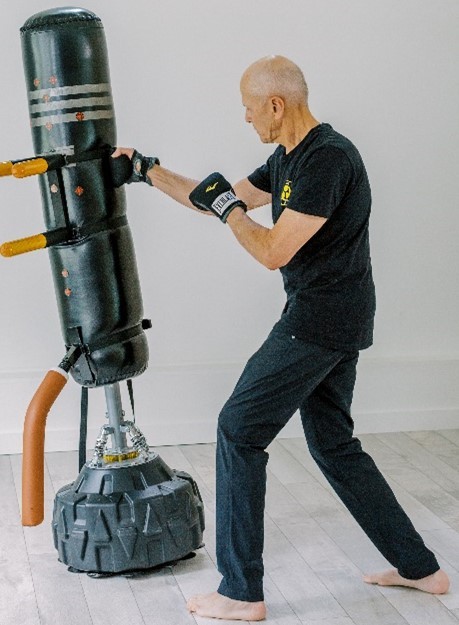By Justin Testa –
Prolonged and extreme conditioning techniques, like body pounding (Shime), hand conditioning, and breaking solid objects, can lead to chronic joint pain, microfractures, and injuries to ligaments and tendons. Recognizing these dangers is essential for the safety and health of karateka at all skill levels. I recommend a cautious and balanced approach. Investing time in supplementary exercises provides greater benefits than focusing on intense body conditioning practice.
This column covers the safe use of supplemental impact-type training aids. To get the most out of these training aids, emphasize accuracy, correct body positioning, and biomechanics. Gradually increasing intensity over time.
Two types of bags can be used for training: the hanging heavy bag and the pedestal bag. Both are excellent training aids, but their physical characteristics and actions should be taken into consideration during practice.
A heavy hanging bag weighs between 70 and 190 lbs. (31 – 86 kg) and is suspended from either a stand or the ceiling. When struck, the bag yields and swings, which can complicate follow-up strikes and introduce risks to the practitioner. This natural movement of the bag can also enhance training; for instance, practitioners can refine their timing by attempting to hit the bag as it swings into an optimal position—this technique is advanced and should not be attempted unless you are experienced. Additionally, if the bag is not struck squarely, it may spin, leading to unintended shifts in balance and errant strikes.
The pedestal bag has become a favored option for home training due to its space-saving design with no installation requirement. While various pedestal bags are available, the majority necessitate filling the base with water or sand. Some models also include suction cups and springs to ensure they stay in place securely. Unlike swinging bags, pedestal bags have minimal “give” when struck. The combined weight of the base and spring action, found in specific models, delivers what is known as “persistent resistance,” which means the bag pushes back against whatever strikes it. This action is like that of a makiwara.
Your primary goal when hitting the bag is to enhance accuracy, balance, and body mechanics during single or multiple strikes. While it may be appealing to go all out and “spar” with your bag, this can be risky, especially if you’re moving quickly to mimic “realism.” If you decide to spar with the bag, take it slowly.
Let’s turn to the dos and don’ts of hitting a bag or other impact training aids.
- Do wrap your hands.
• Hand wraps are inexpensive ($5 – 10 USD) and help prevent unnecessary sprains and breaks. I recommend the Mexican-style wrap because its stretchy material is better suited to your hand. Many martial artists resist this protection because they think that, as karate practitioners, their hands should be tough. Don’t be stubborn. - Do wear bag gloves over the wraps.
• Yes, wear both! Everlast makes lightweight MMA bag gloves made of neoprene ($25) that fit over wraps, retain flexibility in the hands, and keep the thumb free. - Place shooting targets on the bag that correspond to the body targets to help you practice the accuracy of your strikes.
- Do hit the bag with a closed seiken fist.
- Don’t hit the bag with a shoken or a hiraken.
- Do strike the bag with a shuto (knife-edge).
- Don’t hit the bag with a nukite (fingertips), kakushiken (crane beak), boshiken (thumb), or ridge hand.
- Do strike the bag with your elbow, but pay special attention to your body position and the timing of the elbow strike.
- Do kick the bag with a front kick using the ball or heel of the foot, not your toes.
• It is tempting to kick a bag hard, but keep in mind that the impact of a kick on the bag can put high stress on the ankle, knee, and hip joints, which can lead to problems. - Don’t kick a bag with the knife edge of the foot.
- Do practice a hook kick in close to the bag, hitting with the shin and targeting below the waist height.
- Don’t kick the bag above your waist height.
• High kicks are impractical, and unless you have the necessary flexibility, kicking the bag high can cause you to lose balance, fall, or strain muscles. - Don’t strike the bag with your knees forcefully—practice knee strikes with slow contact with the bag, concentrating on the accuracy of the strike.
- Don’t headbutt the bag.
The dos and don’ts outlined above apply to the makiwara, Wing Chin, and Bob dummies. I recommend using these supplementary training aids to elevate your training experience. Remember that mastering the safe and effective use of the bag takes time and patience.
Practice safely!


